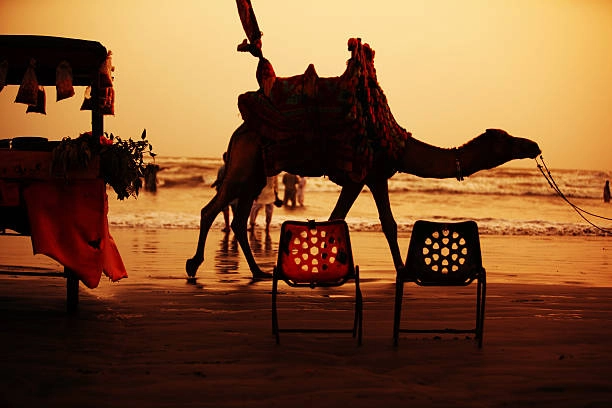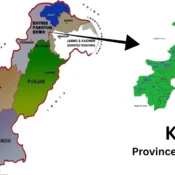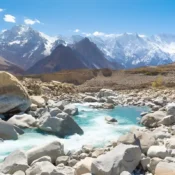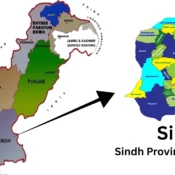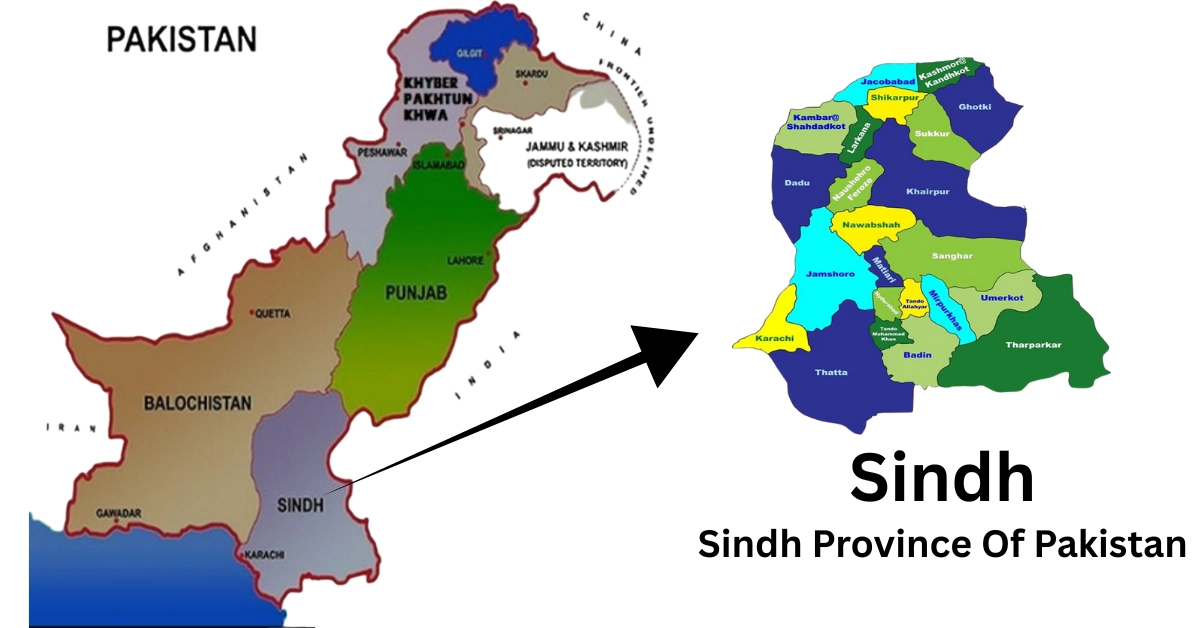
Explore Sindh: Land of Heritage, Culture & Trade
Quick Facts About Sindh
- Population: The population of Sindh in 2025 is projected at around 58 million, based on the 2023 Census report and its annual growth rate (Pakistan Bureau of Statistics).
- Capital: Karachi
- Major Rivers: Indus River
- Languages: Sindhi, Urdu, Balochi
- Literacy Rate: 57.5% (Economic Survey 2024–25) Business Recorder
- GDP Contribution: Approximately 23.7% of Pakistan’s GDP Wikipedia
Sindh: The Land of the Indus
Sindh is where Pakistan’s story begins, the land of the mighty Indus River and the cradle of one of the world’s earliest civilizations, the Indus Valley. Here, ancient ruins like Mohenjo-daro whisper tales from 2500 BCE, while modern Karachi roars as a global megacity of over 20 million people.
The province is a blend of contrasts: deserts and fertile plains, shrines and skyscrapers, tradition and innovation. In rural Sindh, you’ll see farmers tending rice and wheat fields along the riverbanks, while in Karachi, stock markets, sea ports, and technology hubs drive the nation’s future.
Sindh is also the cultural soul of Pakistan, home to vibrant Sindhi Ajrak and Topi, the spiritual music of Sufi saints, colorful festivals, and the irresistible aroma of Sindhi biryani. It’s a land where history and modern life live side by side, shaping Pakistan’s identity.
History & Heritage of Sindh
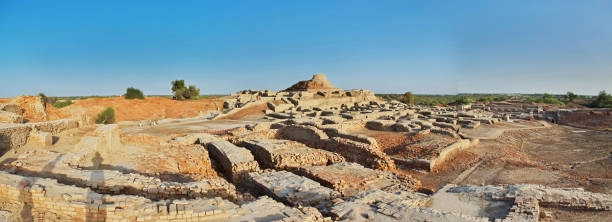
Sindh is often called the “Cradle of Civilization”, home to the Indus Valley Civilization ( 2500 BCE). The ruins of Mohenjo-daro, a UNESCO World Heritage Site, showcase one of the world’s earliest examples of urban planning with brick houses, drainage systems, and marketplaces.
After the decline, Sindh became a hub of Buddhism and Hinduism, leaving behind stupas, temples, and the vast Makli Necropolis in Thatta, one of the largest graveyards in the world.
In 711 CE, Sindh became the gateway of Islam when Muhammad bin Qasim conquered Debal. The Bhambore Mosque, built soon after, is the oldest mosque in South Asia.
From the Sufi saints like Lal Shahbaz Qalandar and Shah Abdul Latif Bhittai to the Kalhora dynasty and later the British, Sindh’s heritage reflects resilience, spirituality, and cultural richness.
Quick Fact: Mohenjo-daro’s Great Bath is the world’s oldest known public water tank, over 4,000 years old.
Geography & Climate of Sindh
Sindh is a land of contrasts, where fertile river valleys meet vast deserts, and where the Arabian Sea kisses the southern edge of the province. Covering an area of 140,914 km², Sindh is Pakistan’s third-largest province by area, yet one of the most densely populated, with nearly 58 million people (2025 est.).
1. The Indus River – Sindh’s Lifeline
The mighty Indus River flows like a spine through Sindh, nourishing its lands and sustaining millions. Towns and cities have grown along its banks for thousands of years. The river’s fertile delta in the south creates one of the largest wetlands in Asia, home to rare species like the Indus dolphin.
2. Plains & Agriculture
Most of Sindh is flat alluvial plains, making it ideal for farming. The Indus Basin irrigation system, one of the largest in the world, allows Sindh to produce wheat, rice, sugarcane, and cotton. Mangoes from Sindh, especially the Sindhri variety, are globally celebrated.
3. Deserts – Thar & Kirthar
- Thar Desert: Stretching across southeastern Sindh, the Thar is both harsh and beautiful. Its sand dunes, camels, and colorful villages create a cultural mosaic. Despite its arid climate, the Thar is home to vibrant festivals and folk traditions.
- Kirthar Range: To the west, rugged hills rise up, forming natural boundaries with Balochistan. The Kirthar National Park preserves wildlife such as ibex, urial sheep, and even leopards.
4. Coastline – Arabian Sea Gateway
Sindh’s southern boundary opens to the Arabian Sea, giving Pakistan its busiest seaport, Karachi Port. The Indus Delta’s mangrove forests, though threatened, remain vital ecosystems. Coastal towns like Keti Bunder and Thatta once thrived as trading hubs, linking Sindh with the Middle East and beyond.
5. Climate – Hot, Dry, but Diverse
Sindh’s climate is generally arid and hot, with scorching summers often crossing 45°C. Winters are mild and pleasant, especially along the coast. The Thar Desert can be dry and unforgiving, but the Indus plains remain green and fertile thanks to irrigation.
Fact: The Thar Desert in Sindh is one of the world’s most densely populated deserts, with over 1.6 million people living in small villages scattered across its sands.
People & Culture of Sindh
If Punjab is known for its energy and warmth, Sindh is remembered for its calm depth, soulful music, and timeless traditions. Life here flows like the Indus River itself, steady, nurturing, and deeply rooted in history.
1. Hospitality & Way of Life
Sindhis are known for their hospitality and gentleness. A guest is treated as a blessing, and homes are often decorated with traditional Ajrak cloths and Sindhi caps, symbols of pride and respect. Festivals, weddings, and even everyday gatherings are filled with color, laughter, and generosity.
Fact: Ajrak, the iconic block-printed shawl of Sindh, dates back over 5,000 years and was even found in Indus Valley archaeological sites.
2. Languages
- Sindhi: The heart language of the province, rich with poetry, proverbs, and folklore.
- Urdu: Widely spoken in urban areas, especially Karachi and Hyderabad.
- Other Languages: Gujarati, Punjabi, Pashto, and Balochi are also heard, reflecting Sindh’s diversity.
3. Faith & Spirituality
Sindh is predominantly Muslim, but its identity has always been shaped by pluralism. Sufi Islam remains central, with shrines like Sehwan Sharif attracting millions of devotees. Alongside, Hindus and Christians form vibrant minority communities, keeping centuries-old temples and churches alive.
Fact: Sindh has one of the largest Hindu populations in Pakistan, especially in districts like Tharparkar and Umerkot.
4. Music & Poetry
Music here is not entertainment — it’s devotion. The Shah Jo Risalo, written by Shah Abdul Latif Bhittai, is sung in soulful melodies across Sindh. Instruments like the ektara and dholak carry verses of love, loss, and mysticism. Sufi qawwalis and the beats of dhamal at Lal Shahbaz Qalandar’s shrine continue to unite people of all backgrounds.
5. Crafts & Artistry
Sindh’s artisans are keepers of ancient skills:
- Ajrak & Sindhi Topi: Symbols of Sindhi pride and culture.
- Sindhi Embroidery: Intricate mirror work, especially from Tharparkar.
- Pottery & Woodwork: Thatta’s blue pottery and Hala’s lacquered wood crafts are world-renowned.
In Sindh, life is a blend of the old and the new, where Sufi poetry echoes in shrines, artisans keep ancient crafts alive, and bustling cities drive modern progress. Whether in a village courtyard shaded by date palms or a Karachi café lit by neon, the Sindhi spirit is the same: warm, soulful, and resilient. It’s a culture that honors its past while embracing the future, making Sindh one of Pakistan’s most vibrant and enduring provinces.
6. Food of Sindh
If Punjab is bold and hearty in its flavors, Sindh brings a richness that is spicy, aromatic, and soulful. The food here reflects the province’s diverse geography, from coastal seafood to desert staples, and the cultural layers left behind by Arab, Persian, Mughal, and local traditions.
-
Everyday Staples:
In villages, the daily meal often revolves around roti or chapati paired with lentils, vegetables, or meat curries. Dates, grown in abundance in Sindh, are eaten fresh or dried and find their way into both savory and sweet dishes
-
Signature Dishes:
- Sindhi Biryani: A fiery, fragrant rice dish with layers of mutton, chicken, or beef, laced with potatoes, chilies, and a tangy hint of yogurt.
- Sindhi Curry (Kadhi): A chickpea flour–based curry simmered with vegetables, often eaten with rice.
- Sai Bhaji: A wholesome blend of spinach, lentils, and spices, nutritious, comforting, and uniquely Sindhi.
- Palla Fish: A delicacy from the Indus River, often grilled or cooked with tamarind for a tangy kick..
- Sindhi Biryani: A fiery, fragrant rice dish with layers of mutton, chicken, or beef, laced with potatoes, chilies, and a tangy hint of yogurt.
-
Street Foods:
In Karachi and Hyderabad, food streets come alive at night. From bun kebabs sizzling on hot griddles, to spicy chaat Pappdi with chutneys, and crispy pakoras sold on corners, Sindh’s street food is a carnival of flavors.
-
Sweets & Desserts:
- Laddu and mithai for celebrations.
- Rabri and falooda as cooling summer treats.
- Pera of Khairpur and Karachi halwa are famous across Pakistan.
-
Drinks:
Sweet lassi, chilled sugarcane juice, and Thadal (a traditional almond, poppy seed, and spice drink) are popular thirst quenchers, especially in the hot Sindhi summers.
Fact: Sindhi Biryani is so popular that it has become one of Pakistan’s most iconic dishes, often found in restaurants and homes far beyond Sindh itself.
Festivals & Celebrations
Sindh is a land where faith, music, and color come together in festivals that pulse with life. These celebrations reflect both its spiritual depth and cultural joy, uniting people across faiths and communities.
-
Sufi Urs Festivals:
The heart of Sindh’s cultural calendar beats at the shrines of Sufi saints. The Urs of Lal Shahbaz Qalandar in Sehwan Sharif is the most famous, where thousands gather for days of qawwali, dhamal (ecstatic dance), and shared meals. The air fills with devotion and music, making it one of Pakistan’s most vibrant spiritual gatherings.
-
Eid Celebrations:
Like the rest of Pakistan, Eid al-Fitr and Eid al-Adha are celebrated with prayers, feasts, and family reunions. In Sindh, these days also bring bazaars alive with traditional clothes, jewelry, and sweet shops packed with eager customers.
-
Sindhi Cultural Day:
Sindhi cultural day held every December, this modern festival celebrates Sindh’s identity. People proudly wear the Ajrak (block-printed shawl) and Sindhi Topi (traditional cap), while parades, songs, and poetry recitals honor the province’s heritage.
-
Other Celebrations:
Sindhi cultural day held every December, this modern festival celebrates Sindh’s identity. People proudly wear the Ajrak (block-printed shawl) and Sindhi Topi (traditional cap), while parades, songs, and poetry recitals honor the province’s heritage.
-
Other Celebrations:
- Diwali and Holi are joyfully celebrated by Sindh’s Hindu community, especially in districts like Tharparkar and Hyderabad.
- Cheti Chand, the Sindhi New Year, marks the birth anniversary of Jhulelal, the community’s patron saint, celebrated with processions and prayers.
- Colorful fairs (melas) are held across towns and villages, featuring folk music, handicrafts, and traditional food.
- Diwali and Holi are joyfully celebrated by Sindh’s Hindu community, especially in districts like Tharparkar and Hyderabad.
Fact: The Urs of Lal Shahbaz Qalandar in Sehwan attracts more than half a million pilgrims every year, making it one of the largest religious gatherings in South Asia.
Cities of Sindh
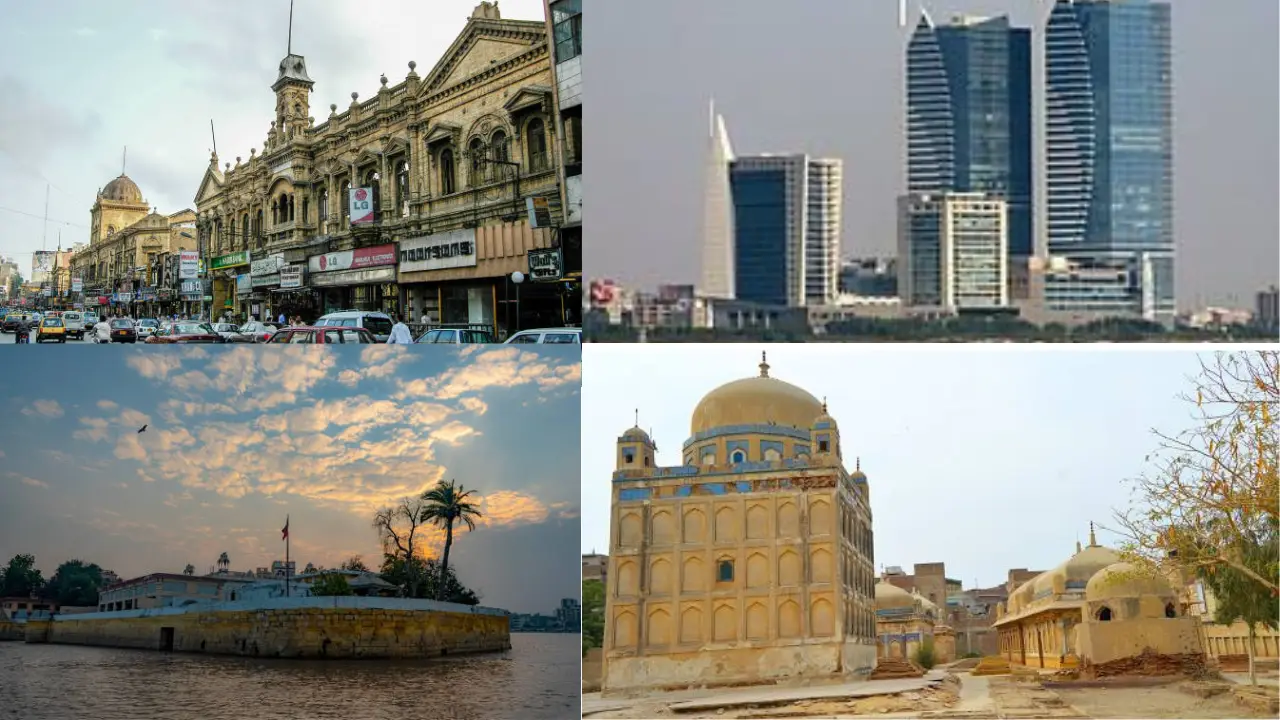
Sindh’s cities are a fascinating mix of ancient history and modern growth — from Karachi’s bustling skyline to Thatta’s crumbling but glorious past. Each city has its own heartbeat, shaped by trade, culture, and resilience.
-
Karachi – The City of Lights:
Pakistan’s largest city and financial hub, Karachi is a metropolis of over 18 million people. From Clifton Beach to Saddar’s chaotic bazaars, Karachi is where modern skyscrapers rise alongside colonial-era buildings. The city never sleeps, buzzing with trade, art, and an energy that defines Pakistan’s economy.
Fact: Karachi handles over 60% of Pakistan’s imports and exports through its two main ports — Karachi Port and Port Qasim. -
Hyderabad – The City of Winds:
Once the capital of Sindh under the Kalhoros and Talpur, Hyderabad is now a major industrial and cultural center. Famous for its glass bangles, ajrak printing, and lively bazaars, it remains a city of artisans.
Fact: Hyderabad produces nearly 80% of Pakistan’s glass bangles, making it a hub of traditional craft.
-
Sukkur – Gateway to Upper Sindh:
Located on the banks of the Indus, Sukkur is home to the iconic Lansdowne Bridge and Sukkur Barrage, both engineering marvels. The city connects Sindh’s north to its south, serving as a key transport and trade hub.
Fact: The Sukkur Barrage, built in 1932, irrigates around 7.5 million acres of farmland, making it one of the largest irrigation systems in the world.
-
Larkana – City of Bhutto’s:
Best known as the hometown of the Bhutto family, Larkana also lies close to Mohenjo-Daro, one of the world’s oldest cities. It blends political legacy with ancient heritage, attracting both historians and political followers.
-
Thatta – The Forgotten Capital:
Once Sindh’s capital during the Samma dynasty, Thatta is dotted with historical landmarks like Shah Jahan Mosque and the vast necropolis of Makli Hill. Though quieter today, its ruins speak of a glorious past.
Fact: Makli Necropolis is one of the largest in the world, with over 500,000 tombs spread across 10 square kilometers.
-
Mirpurkhas – Land of Mangoes:
Known for its lush orchards, Mirpurkhas is the center of Sindh’s mango cultivation. Its produce, especially the Sindhri mango, is exported worldwide.
Fact: Mirpurkhas hosts Pakistan’s oldest Mango Festival, started in 1955, celebrating its juicy reputation.
-
Nawabshah:
An important agricultural and commercial hub, Nawabshah is famous for cotton, sugarcane, and higher education institutions.
Fact: The city is also home to Quaid-e-Awam University, one of Sindh’s leading engineering universities. -
Khairpur – City of Palaces:
Known for its date production and royal heritage, Khairpur still boasts stunning palaces like Faiz Mahal, a reminder of its princely state past.
Fact: Khairpur produces around 150,000 tons of dates annually, supplying both local and international markets.
Sindh’s story doesn’t stop at its major urban centers. Beyond Karachi, Hyderabad, and Sukkur, countless smaller towns and districts add their own charm and importance. Shikarpur, once called the “Paris of the East,” is remembered for its historic havelis and trade routes. Umerkot is steeped in Mughal history as the birthplace of Emperor Akbar. Dadu is a gateway to Gorakh Hill, often called the “Murree of Sindh.” Tharparkar, with its desert festivals and temples, showcases a unique blend of Sindhi and Hindu culture. Together, these cities and towns form a vibrant mosaic, proving that Sindh is not just a province, but a living museum of history, culture, and resilience.
Economy of Sindh
Sindh is Pakistan’s second-largest province by population and the economic powerhouse of the country. Thanks to its coastline, fertile plains, and industrial hubs, Sindh contributes around 23.7% to Pakistan’s GDP and plays a vital role in trade, manufacturing, and agriculture. Karachi, often called the “economic engine of Pakistan”, is not just Sindh’s capital but the country’s financial heart, hosting the Pakistan Stock Exchange, major banks, and the busiest seaport in the nation.
1. Agriculture – Feeding the Nation
Sindh’s plains, nourished by the mighty Indus River, make it one of Pakistan’s key agricultural regions. The province produces 38% of Pakistan’s rice, 30% of its sugarcane, and 12-15% of its wheat. Cotton and chilies are also major crops, while Sindh’s date palm orchards in Khairpur and mango farms in Mirpurkhas are world-renowned. Agriculture not only sustains the local population but also drives the province’s agro-based industries like textiles and sugar mills.
2. Industry – Karachi & Beyond
Karachi is the industrial hub of Pakistan, with sectors ranging from textiles, cement, steel, chemicals, pharmaceuticals, and automobiles. Sindh is home to two of Pakistan’s largest seaports, Karachi Port and Port Qasim, handling over 95% of the country’s international trade. Export processing zones and industrial estates across Karachi, Hyderabad, and Kotri further strengthen Sindh’s industrial backbone.
3. Energy & Natural Resources
Sindh is rich in energy reserves, particularly coal, oil, and gas. The Thar Coal Project in Tharparkar is one of the largest coal reserves in the world, with the potential to power Pakistan for decades. The province also contributes significantly to the nation’s natural gas supply (from fields in Badin and Hyderabad) and is seeing rapid investment in renewable energy, especially wind corridors near Thatta and Jhimpir.
4. Services & Finance
With Karachi as the country’s financial hub, Sindh leads in the services sector. Banking, telecommunications, IT, and trade are concentrated in the province. Karachi’s growing tech and startup ecosystem is putting Sindh on the map for innovation, while its stock exchange and financial institutions continue to influence the national economy.
At a Glance – Sindh’s Economic Contribution
|
Sector |
Contribution to Sindh Economy | Key Highlights |
|
Agriculture |
23% of Sindh’s GDP | Rice, wheat, cotton, sugarcane, mangoes, dates |
| Industry | 30% | Karachi’s industrial estates, seaports, exports |
| Energy | 20%+ | Thar coal, Badin gas fields, wind & solar power |
| Services | 27% | Finance, trade, IT, banking, stock exchange |
Quick Fact: Sindh hosts Pakistan Stock Exchange (PSX), one of South Asia’s oldest stock exchanges, and Karachi Port, the largest and busiest deep-water seaport in Pakistan.
Education in Sindh
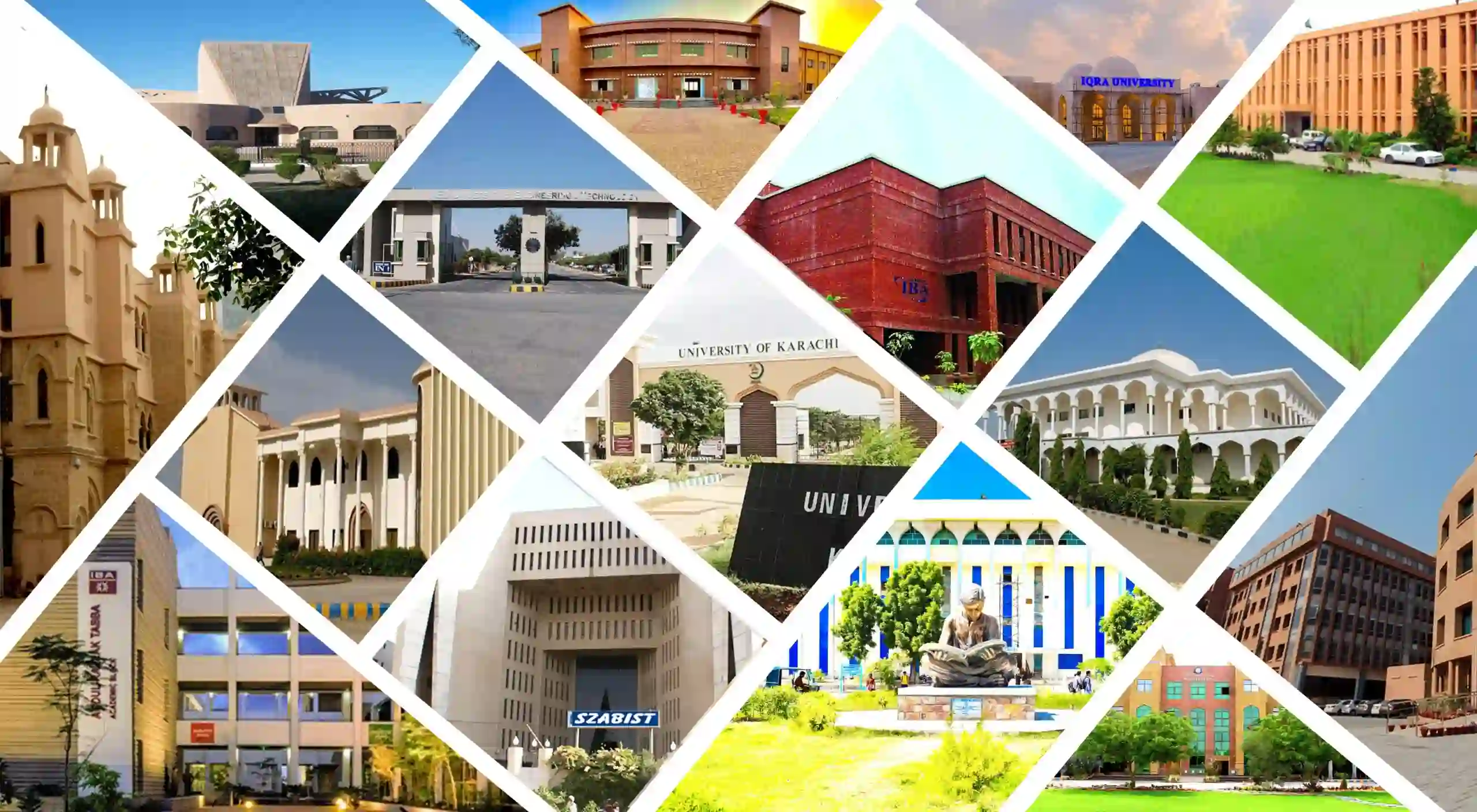
Sindh is home to some of Pakistan’s most prestigious institutions, especially in Karachi and Jamshoro.
-
University of Karachi (est. 1951, Karachi)
One of the largest and most diverse universities in Pakistan, the University of Karachi ranked among Asia’s Top 500 universities in the QS Asia University Rankings 2025. It is well-regarded for its academic excellence in natural sciences, social sciences, and research.
-
IBA Karachi – Institute of Business Administration (est. 1955, Karachi)
Pakistan’s oldest business school and a pioneer in economics, finance, and management education. IBA enjoys global recognition for its rigorous academic standards and strong alumni network in business and public policy. (IBA Official)
-
Dow University of Health Sciences (est. 1945, Karachi)
A premier medical institution, Dow University is known for its clinical training and research in health sciences. In 2025, it featured in the Times Higher Education World Rankings and remains a key contributor to Pakistan’s healthcare sector.
-
NED University of Engineering & Technology (est. 1921, Karachi)
One of Pakistan’s oldest engineering institutions, NED University ranked in the Top 400 in Asia (QS Asia Rankings 2025). It is celebrated for its programs in civil, electrical, and mechanical engineering.
-
University of Sindh (est. 1947, Jamshoro)
Established soon after independence, the University of Sindh has long been a hub for education in literature, education, and the social sciences. It holds a central place in the academic and cultural landscape of the province. (University of Sindh)
-
Mehran University of Engineering & Technology (est. 1963, Jamshoro)
Recognized globally for its work in civil engineering, water resources, and environmental sustainability, MUET continues to drive innovation in engineering education and research.
Just like Punjab, Sindh is home to a wide range of public and private universities that contribute significantly to education, innovation, and development. With historic institutions and emerging centers of excellence, the province remains a vital part of Pakistan’s higher education landscape.
Quick Fact: Karachi is called the “Education Capital of Pakistan” — it hosts more universities and degree-awarding institutes than any other city.
Arts, Handicrafts & Entertainment
Sindh’s culture is stitched, carved, and sung into its arts. Every craft carries a story, every performance echoes tradition, and every piece of art reflects the spirit of its people.
1. Handicrafts – Threads of Heritage
Sindh’s handicrafts are world-famous for their vibrant colors and intricate detail.
- Ajrak: The pride of Sindh, this block-printed shawl in indigo, crimson, and white patterns is more than fabric, it’s an identity, worn in celebrations, rituals, and daily life.
- Sindhi Topi : Embroidered cap with fine mirror work, it remains a cultural symbol, often paired with Ajrak.
- Rilli Quilts: Handmade patchwork quilts with bold geometric patterns, stitched lovingly in rural homes, are prized for both warmth and artistry.
- Blue Pottery of Hala: The town of Hala is renowned for its cobalt blue glazed pottery and woodwork, traditions passed down for centuries.
Quick Fact: Sindhi Ajrak is believed to date back more than 4,000 years, with its patterns inspired by the Indus Valley Civilization motifs.
2. Arts & Music – The Soul of Sindh
Sindh’s music is deeply spiritual, rooted in Sufi traditions. The verses of Shah Abdul Latif Bhittai, set to the simple strings of the tamburo or ektara, still move hearts centuries later. From folk singers in village gatherings to international festivals, Sindhi music bridges the past and present.
- Instruments: The dholak, tamburo, and algoza (double flute) are iconic to Sindhi folk music.
- Sufi Poetry: Shah Latif’s Shah Jo Risalo remains the soul of Sindhi literature, sung in shrines and cultural festivals.
In Sindh, art isn’t just an expression — it’s a way of living. From the bold colors of Ajrak to the haunting verses of Shah Latif, from handcrafted pottery to television screens, Sindh’s creativity continues to thrive, evolve, and inspire. It is this blend of ancient craft and modern expression that keeps Sindh’s cultural heartbeat strong.
3. Entertainment – From Folk to Film
- Theatre & Dance: Sindh’s folk dances like Jhumar are performed at weddings and festivals, symbolizing joy and unity.
- Lollywood & Karachi’s Media Industry: Karachi is the hub of Pakistan’s television and film production, home to major studios, morning shows, and drama serials watched worldwide.
- Literature & Festivals: The Karachi Literature Festival has become an international platform, drawing writers, poets, and thinkers from across the globe.
Quick Fact: Shah Abdul Latif Bhittai’s shrine in Bhit Shah is not just a spiritual center — it’s also a cultural stage where folk musicians gather every Thursday night to keep Sindh’s oral traditions alive.
Sports in Sindh
In Sindh, sports are more than just games — they are a celebration of community, passion, and pride. From dusty village grounds where traditional games thrive to Karachi’s international stadiums, sports in Sindh reflect both heritage and modern ambition.
1. Traditional Games – The Roots of Play
- Malakhra Wrestling: A centuries-old Sindhi sport where wrestlers lock waistbands and battle in dusty arenas, cheered on by entire villages. More than competition, it’s a cultural event, often tied to fairs and festivals.
- Kodi Kodi & Wanjh Watti: Rural children still play these traditional tag and chasing games, keeping alive the simple joys of Sindhi folk sports.
- Camel Racing in Tharparkar: In the desert towns, camel racing is not just entertainment but also a proud part of Sindh’s desert culture.
Quick Fact: Malakhra wrestling is so embedded in Sindhi tradition that every fair (mela) in the province usually hosts a tournament, drawing participants from across Pakistan.
2.Modern Sports – Karachi, the Sporting Hub
Sindh is also home to some of Pakistan’s most important sports infrastructure.
- Cricket: Karachi’s National Stadium is one of Pakistan’s premier cricket grounds, where international matches light up the city. The Karachi Kings in the Pakistan Super League (PSL) ignite the province’s cricket passion every season.
- Hockey: Once Pakistan’s national pride, hockey still finds a strong base in Sindh, with Karachi producing several legendary players.
- Boxing & Martial Arts: Lyari, a neighborhood of Karachi, is known as the “boxing nursery of Pakistan,” producing champions who have represented the country at global levels.
Quick Fact: Lyari in Karachi has produced more than 30 national-level boxers, many of whom trained in makeshift gyms powered by sheer determination.
3. Sports for All – Rising Inclusivity
- Sindh has increasingly embraced inclusive sporting events, from women’s cricket tournaments in Karachi to school-level football competitions in Hyderabad. Local academies are nurturing new talent in football, badminton, and athletics, ensuring the next generation carries the torch forward.
From the raw energy of Malakhra wrestling in dusty rural arenas to the roar of cricket fans in Karachi’s stadiums, Sindh’s sporting spirit is both diverse and unifying. Here, games are more than a pastime — they are proof of resilience, passion, and a love for community that binds people together across generations.
Places to Visit in Sindh
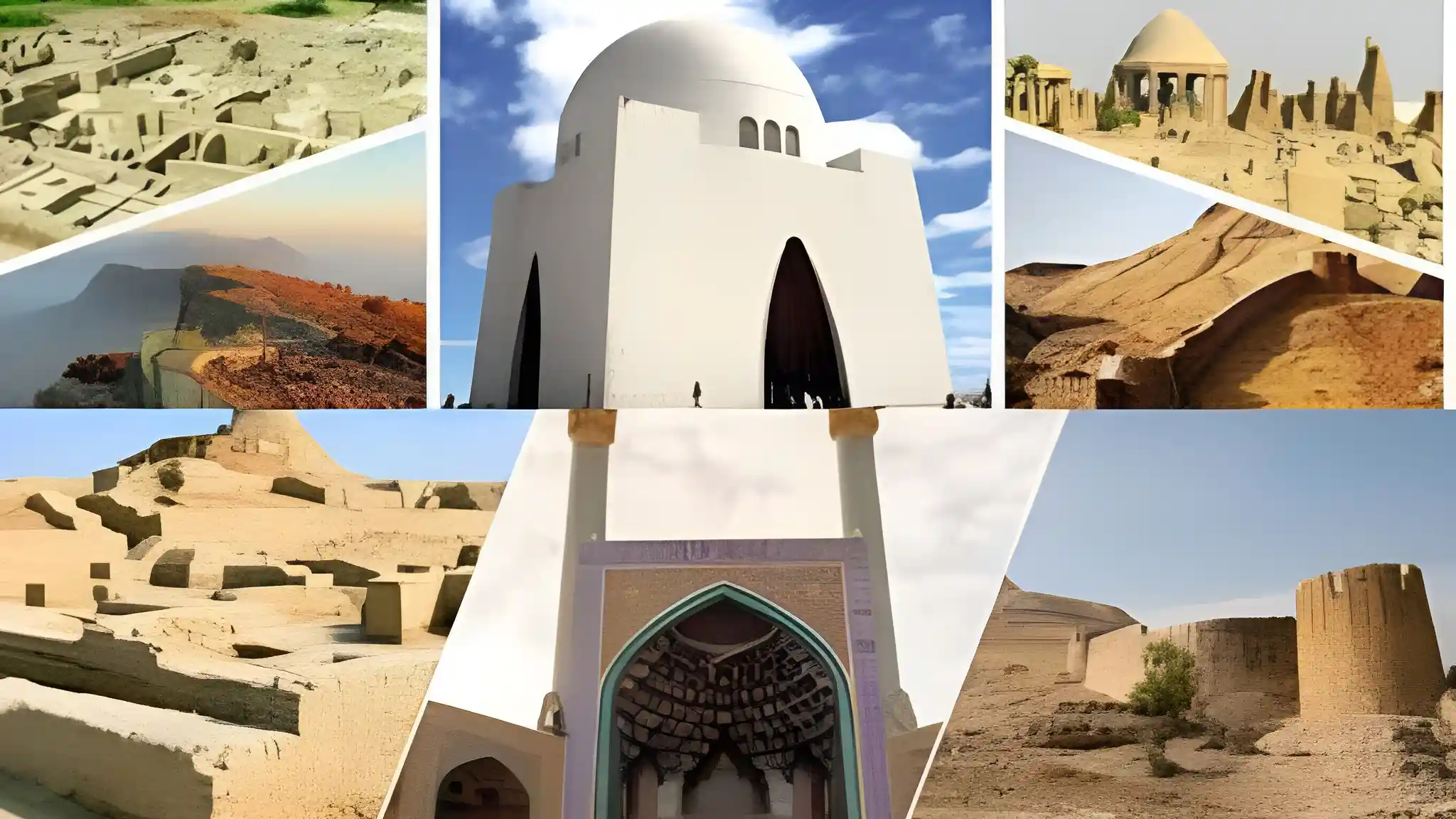
Sindh is a land where history, spirituality, and nature all converge. From ancient ruins that shaped civilizations to shrines that inspire millions, the province is filled with treasures waiting to be explored.
-
Mohenjo-Daro (Larkana District)
One of the world’s oldest urban settlements, Mohenjo-Daro was a jewel of the Indus Valley Civilization (c. 2500 BCE). Its planned streets, drainage systems, and artifacts reveal a society ahead of its time.
Fact: Mohenjo-Daro is a UNESCO World Heritage Site and is often called the “Mound of the Dead.”
-
Makli Necropolis (Thatta)
Among the largest graveyards in the world, Makli spreads across 10 square kilometers and houses tombs of rulers, saints, and scholars from the 14th–18th centuries. Its sandstone carvings showcase Sindhi artistry at its peak.
Fact: Over 500,000 monuments and tombs are believed to exist in Makli, making it a city of the dead unlike any other.
-
Shah Jahan Mosque (Thatta)
Built by the Mughal Emperor Shah Jahan in the 17th century, this mosque is famed for its geometric tile work and incredible acoustics — a prayer whispered in one corner can be heard across the hall.
Fact: The mosque contains 93 domes, the largest number in any structure in Pakistan.
-
Clifton Beach (Karachi)
The Arabian Sea’s waves crash against Karachi’s coast at Clifton Beach, a favorite escape for families, horseback riders, and camel owners offering rides at sunset.
Fact: Clifton was once famous for its “rocky oyster beds,” where pearls were occasionally found.
-
Ranikot Fort (Jamshoro District)
Nicknamed the “Great Wall of Sindh,” Ranikot Fort stretches for about 32 kilometers, making it one of the largest forts in the world. Its massive walls wind across rugged hills, offering breathtaking views.
Fact: Ranikot is so vast that it could enclose an entire city within its walls.
-
Keenjhar Lake (Thatta)
Also called Kalri Lake, this freshwater lake is a haven for migratory birds and a favorite picnic spot. It is also linked to the tragic Sindhi love story of Noori and Jam Tamachi.
Fact: Keenjhar Lake supplies drinking water to Karachi, serving millions of people daily. -
Sehwan Sharif (Jamshoro District)
Home to the shrine of Lal Shahbaz Qalandar, Sehwan is one of Pakistan’s most visited spiritual sites. The annual urs festival fills the city with qawwali, dhamaal, and an atmosphere of devotion.
Fact: The shrine attracts over half a million pilgrims every year during urs celebrations. -
Gorakh Hill Station (Dadu District)
Often called the “Murree of Sindh,” Gorakh Hill offers cool weather and panoramic views at 5,689 feet above sea level — a rare mountain retreat in otherwise arid Sindh.
Fact: In winter, Gorakh Hill occasionally receives snowfall, making it one of the few places in Sindh to experience it.
Sindh’s landscapes are as varied as its history — from the ruins of Mohenjo-Daro to the waves of Clifton, from the mystical air of Sehwan Sharif to the walls of Ranikot. Each site is a window into Sindh’s soul, offering travelers a journey through time, faith, and beauty.
Incredible Facts About Sindh
Sindh is more than just a province — it’s a land where civilizations were born, cultures flourished, and legends still live. Here are some fascinating facts that capture the essence of Sindh:
-
Cradle of Civilization
Sindh is home to Mohenjo-Daro, one of the main cities of the Indus Valley Civilization (2500 BCE). This makes Sindh not just important for Pakistan but for all of human history.
Fact: Mohenjo-Daro had advanced drainage systems that rival many modern cities.
-
City of Saints & Sufis
Sehwan Sharif, home of Lal Shahbaz Qalandar, and countless other shrines make Sindh a spiritual heartland.
Fact: Every year, the urs of Lal Shahbaz Qalandar draws over half a million pilgrims from across South Asia. -
Largest Fort in the World
Ranikot Fort in Sindh is so massive (about 32 km in circumference) that it’s often called the Great Wall of Sindh.
Fact: It is one of the largest forts on Earth, big enough to enclose an entire city.
-
UNESCO Treasures
Sindh boasts multiple UNESCO World Heritage Sites — Mohenjo-Daro, Makli Necropolis, and Shah Jahan Mosque in Thatta.
Fact: Makli Necropolis contains over 500,000 monuments, making it one of the largest graveyards in the world. -
Karachi – Pakistan’s Powerhouse
Karachi, Sindh’s capital, is the largest city in Pakistan and one of the most populated cities in the world.
Fact: Karachi contributes about 20% of Pakistan’s GDP and handles nearly all of the country’s international trade through its ports. -
Land of Legends
Sindh is home to some of the most famous folk tales in South Asia, including the tragic romance of Sassi-Punnu and Noori-Jam Tamachi, celebrated in poetry, music, and shrines.
Sindh is not just about its past — it’s about how that past continues to shape the present. From being the cradle of civilization to fueling Pakistan’s economy, from Sufi mysticism to modern megacities, Sindh is a province that holds within it both the memory of history and the promise of tomorrow.
Conclusion – Sindh: Where History Meets Tomorrow
Sindh is a land of contrasts — where the ancient streets of Mohenjo-Daro whisper stories of the world’s earliest cities, while the bustling avenues of Karachi pulse with modern ambition. It is the province where Sufi saints shaped spiritual traditions that still inspire millions, where deserts glow under the sun, where fertile plains feed the nation, and where ports connect Pakistan to the world.
Life in Sindh is lived in vibrant colors, the Sindhi ajrak, the beat of the dhol at shrines, the aroma of Sindhi biryani, and the roar of a cricket crowd at Karachi’s stadium. It is this blend of past and present, faith and festivity, tradition and progress, that makes Sindh not just a province but an identity of resilience and pride.
To truly know Pakistan, one must experience Sindh, its history, its culture, and its people who carry centuries of legacy into the future.
✨ To truly understand Pakistan is to journey through its lands, people, and stories. Explore more of what makes this country extraordinary:
-
Discover the full story of Pakistan: Discovering Pakistan
-
Dive into Punjab’s vibrant heart: Punjab – The Heart of Pakistan
- Khyber Pakhtunkhwa – Gateway To Mountains & Culture: KPK
-
Seek out adventure in every corner with Adventure in Pakistan
Let every blog guide you to new horizons—lands to explore, stories to live, and beauty to share.
Frequently Asked Questions
Q1. What is the detailed history of Sindh, Pakistan, from ancient civilizations to modern times?
Ans: Sindh’s history spans from the Indus Valley Civilization (Mohenjo-Daro, 2500 BCE) to Buddhism, Hindu dynasties, the Arab conquest (711 CE), Sufi influence, Mughal and Kalhora rule, British colonization, and finally becoming part of Pakistan in 1947.
Q2. What type of people are Sindhis, and what defines their culture and identity?
Ans: Sindhis are known for hospitality, spirituality, and rich traditions like Ajrak, Sindhi Topi, Sufi music, and poetry, blending ancient heritage with modern life.
Q3. What was the impact of Arab conquests on Sindh’s history?
Ans: The Arab conquest of 711 CE made Sindh the first South Asian region to embrace Islam, shaping its religion, governance, and cultural links with the Middle East.
Q4. How has the Soomra dynasty influenced Sindhi culture and administration?
Ans: The Soomras (11th–14th centuries) strengthened Sindh’s independence, promoted local governance, trade, and Sindhi literature, leaving a lasting cultural legacy.
Q5. Is Sindh mostly a vast desert, or does it have diverse landscapes?
Ans: Sindh has both deserts like Thar and diverse landscapes — fertile Indus plains, Kirthar hills, and a long Arabian Sea coastline.
Q6. What shared cultural elements exist between Sindhis in Pakistan and India?
Ans: Shared traditions include Ajrak, Cheti Chand, folk tales like Sassi-Punnu, and devotion to Sufi poetry and shrines.
Q7. Why is Sindh economically underdeveloped despite its resources like oil and gas?
Ans: Despite resources and Karachi’s growth, rural Sindh faces underinvestment, weak infrastructure, and governance challenges, causing economic imbalance.
Q8. What are must-visit historical sites in Sindh beyond Karachi?
Ans: Key sites include Mohenjo-Daro, Makli Necropolis, Shah Jahan Mosque, Ranikot Fort, Sehwan Sharif, and Gorakh Hill.

